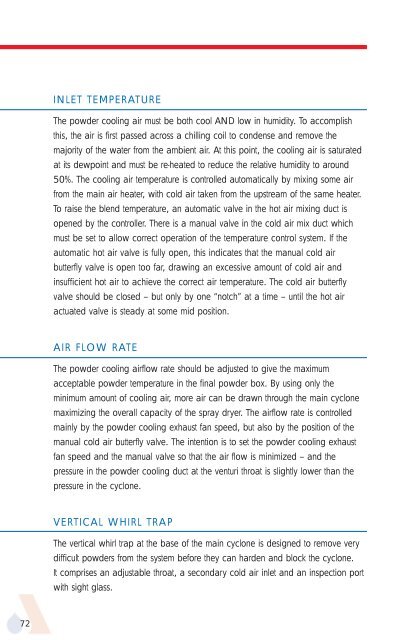APV Dryer Handbook - Umbc
APV Dryer Handbook - Umbc
APV Dryer Handbook - Umbc
You also want an ePaper? Increase the reach of your titles
YUMPU automatically turns print PDFs into web optimized ePapers that Google loves.
72<br />
INLET TEMPERATURE<br />
The powder cooling air must be both cool AND low in humidity. To accomplish<br />
this, the air is first passed across a chilling coil to condense and remove the<br />
majority of the water from the ambient air. At this point, the cooling air is saturated<br />
at its dewpoint and must be re-heated to reduce the relative humidity to around<br />
50%. The cooling air temperature is controlled automatically by mixing some air<br />
from the main air heater, with cold air taken from the upstream of the same heater.<br />
To raise the blend temperature, an automatic valve in the hot air mixing duct is<br />
opened by the controller. There is a manual valve in the cold air mix duct which<br />
must be set to allow correct operation of the temperature control system. If the<br />
automatic hot air valve is fully open, this indicates that the manual cold air<br />
butterfly valve is open too far, drawing an excessive amount of cold air and<br />
insufficient hot air to achieve the correct air temperature. The cold air butterfly<br />
valve should be closed – but only by one “notch” at a time – until the hot air<br />
actuated valve is steady at some mid position.<br />
AIR FLOW RATE<br />
The powder cooling airflow rate should be adjusted to give the maximum<br />
acceptable powder temperature in the final powder box. By using only the<br />
minimum amount of cooling air, more air can be drawn through the main cyclone<br />
maximizing the overall capacity of the spray dryer. The airflow rate is controlled<br />
mainly by the powder cooling exhaust fan speed, but also by the position of the<br />
manual cold air butterfly valve. The intention is to set the powder cooling exhaust<br />
fan speed and the manual valve so that the air flow is minimized – and the<br />
pressure in the powder cooling duct at the venturi throat is slightly lower than the<br />
pressure in the cyclone.<br />
VERTICAL WHIRL TRAP<br />
The vertical whirl trap at the base of the main cyclone is designed to remove very<br />
difficult powders from the system before they can harden and block the cyclone.<br />
It comprises an adjustable throat, a secondary cold air inlet and an inspection port<br />
with sight glass.











